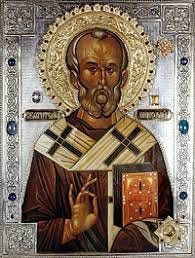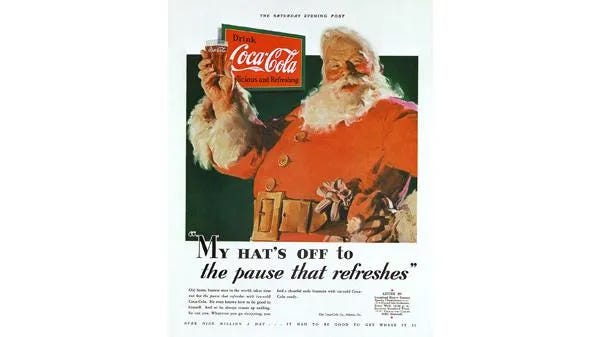Issue #441 Black History Monday, December 18, 2023
Welcome to this Today in Black History post. Black History IS American History, no matter how hard some people try to erase our history and contributions.
A lot of this information is available at yenoba.com, blackfacts.com, and onthisday.com.
This post is free to read/listen to for two days. To have 365 24/7 access to all our posts and podcast episodes and financially support “We Are Speaking” for no more than $5 per month, please subscribe at the paid level.
Today’s Brown and Black WOW!
Like many Boomer-aged people, my parents took me and my sisters to see the white Santa Claus at the department store. I also took my children in the 70s and 80s.
I really don’t remember when I stopped “believing” in Santa or when my own children stopped believing.
I do know that it was only relatively recently that I learned about the original brown St. Nicholas and the market-driven evolution from the real brown person in Asia Minor to the totally fictional white European-based Santa Claus.
St. Nicholas was a real 4th-century Christian bishop who originally hailed from Myra in Turkey. His parents were wealthy, and he was known for his generosity and kindness toward the poor and the sick. St.Nicholas is venerated in many eastern and some western churches and St. Nicholas Day is celebrated on December 6.
One of the most famous miracles ascribed to St. Nicholas involved the gifts of gold coins he gave to a poor man for the dowries for the man’s three daughters.
St. Nicholas heard about the man’s plight and went to his house at night. He then threw three bags of gold coins through the window, and each bag of gold landed in three stockings that were hanging by the fireplace to dry. It is believed that this is why we hang stockings at Christmas and often put chocolate gold coins in the stockings.
St. Nicholas is also the patron saint of children and sailors. The stories of him giving gifts to the poor have inspired the tradition of gift-giving during Christmas time.
In the Netherlands, Sinterklaas is based on the historical St. Nicholas and is depicted as an elderly and stately man with white hair and a long, white, full beard. He wears a long red cape and carries a gold ceremonial shepherd's staff. He is accompanied by his assistant, Zwarte Piet ("Black Pete"), a helper dressed in Moorish attire and blackface. Sinterklaas carries a big, red book that records whether children have been good or naughty, and Black Pete is typically depicted carrying a bag that contains candy for the children, which he tosses around, and he also carries a chimney sweep's broom made of willow branches, used to spank naughty children.
These Dutch traditions were brought to the New World in the early 19th century.
Also in the 19th century, New York writer Washington Irving wrote about a jolly Saint Nicholas figure in his 1809 book, Knickerbocker’s History of New York, reinventing St. Nicholas as a short, stout, merry, pipe-smoking Dutchman.
Civil War Cartoonist Thomas Nast drew many Santa illustrations for Harper’s Weekly in the mid-19th century, including showing Santa as a small elflike figure who supported the Union.
The Coca‑Cola Company began its Christmas advertising in the 1920s with shopping-related ads in magazines like The Saturday Evening Post. The first Santa ads used a strict-looking Claus, in the vein of Thomas Nast.
In 1930, artist Fred Mizen painted a department-store Santa in a crowd drinking a bottle of Coke.
In 1931 the company began placing Coca‑Cola ads in popular magazines showing a wholesome Santa who was both realistic and symbolic. So Coca‑Cola commissioned Michigan-born illustrator Haddon Sundblom to develop advertising images using Santa Claus — showing Santa himself, not a man dressed as Santa.
For inspiration, Sundblom turned to Clement Clark Moore's 1822 poem "A Visit From St. Nicholas" (commonly called "'Twas the Night Before Christmas"). Moore's description of St. Nick led to an image of a warm, friendly, pleasantly plump, and human Santa.
In the 1980s in the United States, some department stores and other venues started depicting Santa Claus as Black, with the same shape and features as the original white Santa Claus.
Black and Brown Santas have been both welcomed and hated by parents and children in America ever since. Stafford Braxton is the owner of a company called “Santas Just Like Me” and tells the happy and sad stories of people’s reactions to the non-white Santas he provides at malls and other locations.
Even today, some white people who see Black Santas at the mall or even Black and brown Santa decorations for sale at department stores revolt, stating that they are emotionally deflated at the sight of Black and brown Santas, declaring, “Santa Claus is white, and so is Jesus!”
In 2023, through the production company of award-winning actor and singer Billy Porter, Incognegro Productions, the short film, “American Santa” was released, and won several awards for short films. The movie details the significance of including the vile and racist voice messages as a stark counterpoint to the profound joy and positivity Stafford and the Santas radiate. By weaving these contrasting narratives together, the director exposes the glaring disparity between the love and acceptance they embody and the ugliness of racism that persists in our society.
The movie was released on December 1 and is also available for viewing on YouTube.
Today In Black History
- In 1865, the 13th Amendment to the Constitution was ratified, outlawing slavery in the United States.
- In 1958, the African country of Niger gained its autonomy within the French Community.
- In 1960, the UN condemned apartheid.
- In 1971, Rev. Jesse Jackson founded the People United To Save Humanity (PUSH) in Chicago.
- In 1996, Kofi Atta Annan became the first Black UN Secretary-General.
- In 1996, the school board of Oakland, California declared “Ebonics” an official English language dialect.
- Let’s discuss these facts in our community on Substack Notes. You can also read other Substack publications without subscribing to them when you join Notes.








